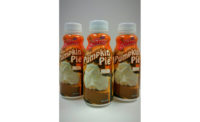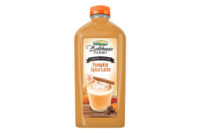To quote Ecclesiastes (and The Byrds): “To every thing there is a season.” And these days, to every season there is a flavor.
In our era of never-ending news cycles and “snaps” that disappear before you see them, limited-time flavors have an innately au courant caché. And as the vogue for eating with the seasons gains wider currency, consumers are actually coming to appreciate that all good things, even all good flavor profiles, come to an end — at least until the same time next year.
Which is why, said Jessica Vogel, marketing communications manager for dairy at Kerry, Beloit, Wis., “Consumers welcome change and look forward to the launch of their beloved seasonal flavors. And for many, these seasonal items are incremental purchases they make in addition to their usual dairy purchases.” So seasonally savvy dairies, step up! If you aim to keep your product lines fresh, change is good.
The time is right
Americans wait all year for their limited-time favorites, said the market-intelligence firm Mintel. It found that 78% of consumers surveyed consider seasonal dishes to be a treat, with more than 42% willingly paying more for them while dining out.
Indeed, the perennial popularity of Shamrock Shakes proves that limited-time offers (LTOs) have found eager audiences for generations. But there’s something about the current moment — actually, a number of things — that makes now an especially auspicious time for seasonal flavor rotation. For one, you can’t discount the pull of the fresh-local-seasonal movement.
“The rise of farmers’ markets and food transparency has led many consumers to focus on what’s in season rather than produce that has to be shipped in from other regions,” noted Teresa Polli, Kerry’s senior manager of marketing communications for taste. “This has caused us to see more summer LTOs featuring traditional seasonal produce such as strawberries, blackberries, rhubarb and cherries.”
Vogel circles back to the power of social media, which “has played a large role in the growth of seasonal flavors,” especially among Millennials and their younger siblings in Generation Z. “When iconic seasonal foods are launched, social media feeds like Instagram and Twitter quickly fill with consumer-generated content and photos,” she noted.
The upshot: 68% of 18- to 34-year-olds agree that their peers’ social posts are somewhat likely or better to influence their own purchases, according to ShareThis data. In fact, so pivotal is social media to the success of Starbuck’s pumpkin-spice latte that the beverage even has a verified Twitter account, @TheRealPSL.
America’s changing demographics might also be feeding our craving for ethnic flavors.
“More traditionally multicultural flavors are becoming mainstream as consumer palates become more adventurous and look continually for a new stimulant,” said Kevin Murphy, the marketing manager for Virginia Dare, Brooklyn, N.Y.
He pointed to the emergence of horchata and dulce de leche profiles in flavored milk, coffee and ice cream as two examples.
As Lisa Miller, marketing director, Ornua Foods North America, Inc., Evanston, Ill., put it, “Consumers are looking for ways to elevate their eating occasions — whether through discovering global cuisines or trying new flavors. Seasonal flavors are a great way to capitalize on this trend.”
And then there’s nostalgia. Not even Millennials can escape its sway, and it’s already rendered apple pie, pecan pie and, yes, pumpkin spice synonymous with “childhood and family memories,” Vogel said. The Hispanic Millennial Project found that 62% of Americans have favorite foods that remind them of their childhood and connections to the past, she noted; meanwhile 27% of Americans in Mintel’s latest research agree that seasonal flavors are nostalgic.
Get it while it lasts
But when you get down to it, said Shannon Cushen, director of marketing, Fuchs North America, Hampstead, Md., the appeal of seasonal flavors “is all about building anticipation with consumers. By not offering pumpkin-spice items the rest of the year, you give consumers something to look forward to. Once that item is here, they’re more likely to indulge in it regularly. They get the whole ‘enjoy it while it lasts’ mentality and tend to go back for more as much as they can until the next season.”
It’s an ingenious strategy — and an emotionally astute one, too, as the moods that seasonal flavors evoke are potent purchasing drivers. Mintel found that seasonal flavors call to mind notions of “comforting” (39%), “special” (39%), “warmth” (33%) and “happy” (30%) — all “positive emotions associated with traditional holiday comfort foods and beverages,” Murphy said.
Dairy delivery
Dairy is a great platform from which to capitalize on seasonal offerings.
“Dairy products have long been the ideal canvas for seasonally rotating flavors,” Vogel said, with everything from peppermint-stick ice cream and eggnog at Christmas to lamb-shaped butter sculptures at Easter.
One reason is that dairy’s base profile is both “very comforting to most consumers” and carries flavors well, said Matt Plaza, an applications technologist at Sensient Flavors, Hoffman Estates, Ill.
Murphy noted that the success of Girl Scout cookie ice cream — more of a seasonal tradition than a holiday — is “a terrific example” of how frozen dairy has benefited from a seasonal theme.
“Consumers are certainly open to seasonal flavor options in their frozen treats,” he said.
They appreciate them in drinkable dairy, too. “Flavored milk has long been suited to seasonal changes,” Murphy continued. “Consumers are willing to buy a quart or single-serve bottle as a treat in addition to their regular purchases of white milk. From a healthy-living perspective, milk is also a more guilt-free purchase than other snack options. And aseptic packaging allows for the any-time-of-day, on-the-go consumption popular with younger generations.”
Weathering seasonal change
But whether we’re talking about flavored milk or frozen yogurt, product profiles don’t just flip with the calendar page. Incorporating seasonally rotating flavors involves the same formulation and production challenges that accompany any new-product launch, not least of which are “determining how much to produce, how many flavors to introduce, the availability of shelf space and how to deliver on the flavor promise,” said Miller.
Denis Neville, the CEO of CoreFX Ingredients, Chicago, said ensuring consistent flowability, color and dispersibility ahead of time when working with powdered ingredients “minimizes operational issues. Ensuring clarity of ingredient SKU labeling or color tags minimizes errors when switching between ingredients seasonally.”
Stephen Cobbe, director of dairy applications at Kerry, said timing “is possibly one of the greatest challenges that processors face” in rotating through seasonal profiles. “Meeting minimum order quantities, lead times, run sizes and launch schedules all need to be considered when launching a new LTO flavor. The time it takes to develop the flavor and validate its final taste, texture and shelf life can be a challenge before moving into production. Specifically, shelf life in the distribution chain from production to the store to the next LTO cycle needs to be planned carefully.”
A taste of the seasons
Setting operations aside, Plaza noted that another barrier to seasonal flavor rotation is the “narrow window of sales on the traditional calendar” limiting some profiles. Take eggnog. Not only do consumers associate it mainly with late fall and winter, but also it has “to stand out on the overwhelming dairy wall in most stores during that timeframe,” Plaza said.
Flavor extensions can make eggnog less of a winter-holiday item, he said.
“There’s tremendous opportunity to include seasonal flavors in a new context as limited-time offerings and during nontraditional seasons,” Plaza said, pointing to Saigon cinnamon eggnog or eggnog featuring Indonesian vanilla.
“These varietal flavors entice the consumer with a unique experience and ‘journey’ that’ll influence their purchase,” Plaza said.
Two upcoming flavors for spring are honeysuckle, which has a delicate and nectar-like flavor, and lemongrass, which has a “subtle similarity to lemon and citrus profiles,” Plaza said.
Murphy noted that Peeps marshmallow flavors have “seen positive results in the springtime as options for both flavored milk and ice cream.”
As for summer, Polli said that a limited catalog of seasonal launches and iconic foods actually gives it “a lot of untapped potential” from a flavor-creation standpoint. “Offering a fruit flavor during the window when it’s in season will play on the consumer trend for fresh, authentic and artisanal foods,” she said.
And that’s just the kind of logic guiding today’s consumers. Limited-time profiles satisfy their cravings not just because they taste great, but because they fit the bigger frame that increasingly shapes consumers’ choices.
Or, as Plaza put it, “Seasonal flavors stand for more than just a specific time of year. They tell a story.”




